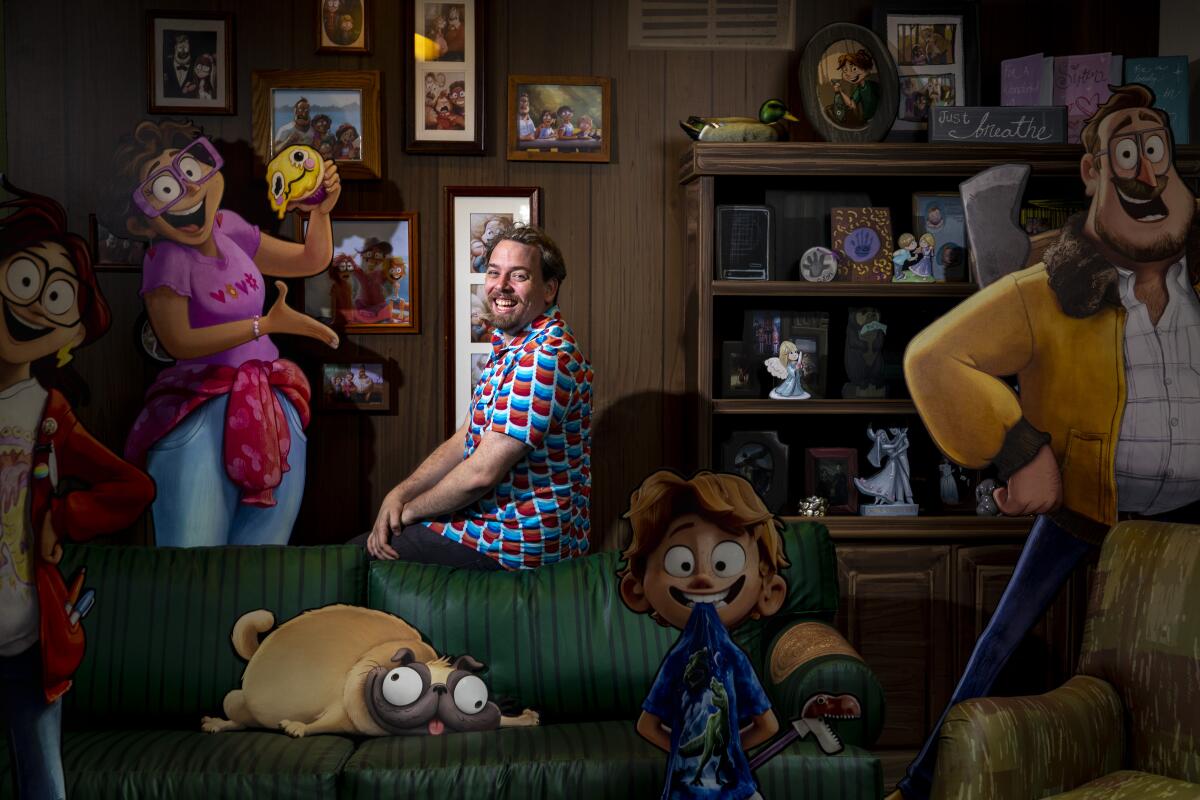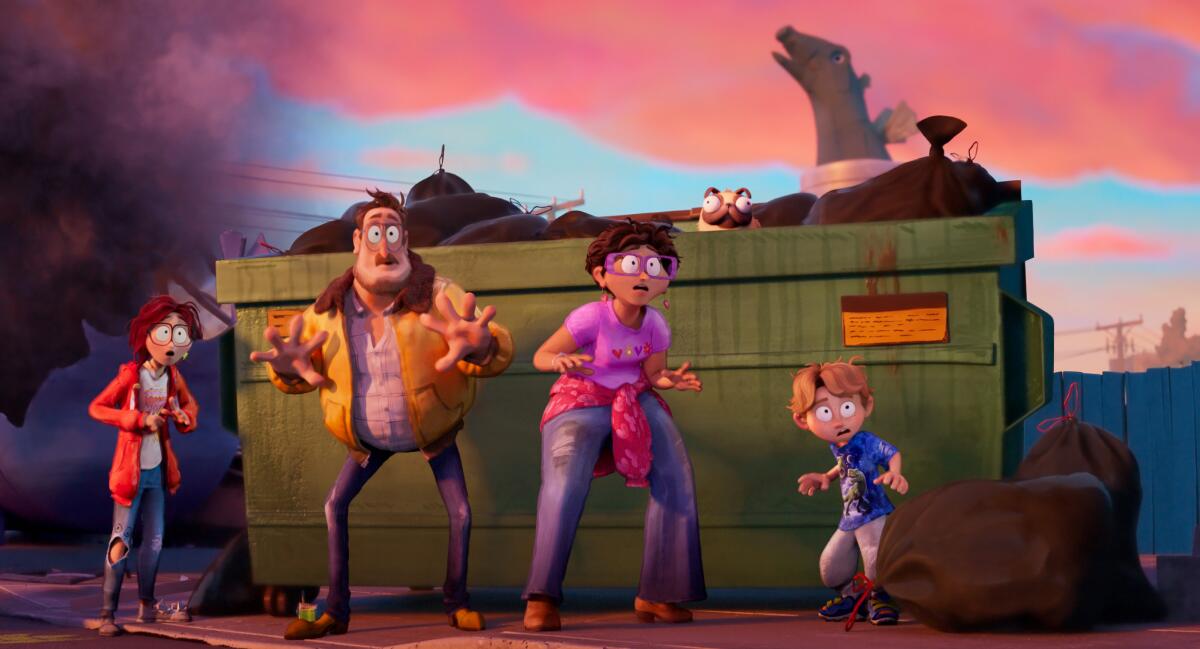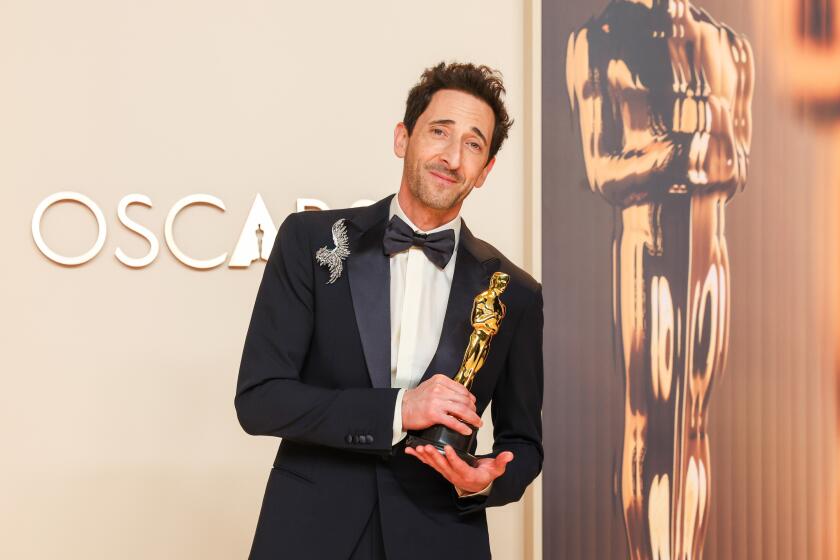‘Mitchells vs. the Machines’ is personal and idiosyncratic — and perfectly imperfect

- Share via
This is an animated comedy in which a robot uprising aims to rid Earth of all humans. But we’re not going to talk about that.
“The dad in the movie looks exactly like my dad. My dad owns that jacket,” says “The Mitchells vs. the Machines” co-writer and co-director Michael Rianda of his animated film. “He’s like” — takes on a deep dad voice — “That sounds suspiciously like Danny McBride [who plays the dad in the movie]. Mike, the guys at the Elks Club are talking. Did you have to make him look exactly like me?’
“So it really does come from a deeply personal place.”
Yes, there are physically improbable chases and fights with robots and giant Furbys, including one wild ride in which the mom, voiced by Maya Rudolph, “murders about 1,000 robots.” But “Mitchells” is about the family. Full stop.
They are a sloppy, messy clutch of imperfect people trying to reconnect before eldest daughter Katie (voiced by Abbi Jacobson) goes across the country to art school. There’s dino-obsessed younger brother Aaron (Rianda) and amiable tongue-hanging pug Monchi, and countless identical robots led by the ultimate evil AI ( who better than Olivia Colman).
Katie rings true where so many animated movies’ outsider-kid protagonists do not.
“It was super important to us that Katie not be too much of a brat and the dad not be too much of a jerk, because when you’re in a family, you want to connect,” says Rianda, citing a scene of father-daughter conflict that used to end with Katie storming out.
“It didn’t work until we had Katie trying to connect with her dad: ‘I made this video about you, don’t you like it?’ And him saying, ‘Ahhh … well … maybe this isn’t going to work out [meaning her career as an artist]. Maybe you should think of a backup plan.’ As soon as we had the characters trying to reach out to each other instead of yelling, it really activated the family.”
There’s a reason the filmmakers had insight into Katie: They were her.

Katie is a combination of several people on the filmmaking team, says Rianda: “Me, because I went to art school and my dad is a very practical man who had a lot of questions. Jeff [Rowe, co-writer and co-director] brought his own stuff. Lindsey Olivares, the production designer, brought a ton from her life visually — like writing on the shoes. We felt like we got there when we showed it to someone in Korea who said, ‘Oh, I drew on my pants like that.’”
Sony Animation hooked Rianda and company up with perhaps the ideal mentors for such a personal, idiosyncratic yet big-budget project: Chris Miller and Phil Lord, filmmaking forces behind “Cloudy With a Chance of Meatballs,” “21 Jump Street” and the Oscar-winning “Spider-Man: Into the Spider-Verse.” Miller and Lord fit right into the weirdo A/V club.
Rianda said, “They poured rocket fuel on all of our crazy ideas. We said, ‘What if Katie was editing the movie?’” — meaning, what if “Mitchells” had idiosyncratic title card breaks in the style of Katie’s bizarro film projects — “‘Are we gonna be thrown in movie jail for this?’ And Chris and Phil were like, ‘YES! GO!’”
Miller says he and Lord pushed for the “Mitchells” crew to ignore conventional wisdom, including in Katie’s character design — why make her conventionally pretty? “Once they started chasing ‘What did I look like, what did I feel like when I was a wannabe filmmaker,’ it got so specific and observed. Abbi Jacobson brought a lot to that specificity.”
Lord says, “We were in a meeting with Kristine Belson, the head of Sony Animation, and she was sitting in a chair with her legs like this —,” he leans perilously far back and throws his feet up near the webcam, “Kind of … doing that —,” he tugs his hair forcefully enough to move his head side to side. “And somebody started drawing that, and that’s what it’s like to be a young kid who’s creative and open. We were showing everybody the drawings and Belson was like, “I like this one!’”
Those character details and perfect imperfections define the film.
Rianda says, “Lindsey Olivares would be like —” putting his fingertips together contemplatively, as Aaron does (described in the script as “hands tented like a businessman”) — “‘Can it be … worse?’ When you’re 8 years old and you’re making a burger puppet, you can see the stitching.
“Since this is about imperfect humans, it would be a crime if they didn’t look wobbly and misshapen, like we are: full of imperfections. So we had to teach a computer to draw like a human. Early versions of the movie looked terrible!” Rianda laughs gleefully.
“We used all the sleek ‘Spider-Verse’ tools to make [the high-tech world]. We wanted the robots to look like a Stanley Kubrick movie. For the human stuff, we were looking at, like, Dogme 95 movies, that cinematography. “
He pauses, then adds, “Kids love Dogme 95!”
More to Read
From the Oscars to the Emmys.
Get the Envelope newsletter for exclusive awards season coverage, behind-the-scenes stories from the Envelope podcast and columnist Glenn Whipp’s must-read analysis.
You may occasionally receive promotional content from the Los Angeles Times.







